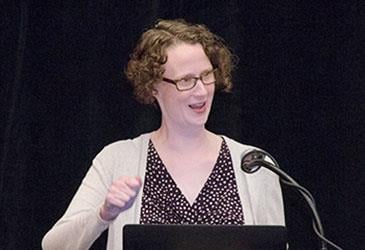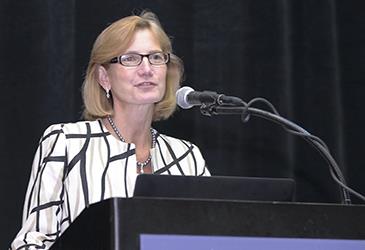For Melissa Hicks, it’s not the constant pain, the fatigue and the host of other symptoms that come with her autoimmune disease that make her sick. “What makes me feel really sick is all the work I have to do because I’m a patient,” she said. “Being sick became another full-time job. … When you’re sick, you can’t do two full-time jobs.”
Burdens of the current health care environment
Hicks, who suffers from Sjogren’s Syndrome, was talking to a room full of physician leaders from health systems around the country during the 2016 AMA Annual Meeting.
She described all the appointments she has to schedule over the phone, the calls to argue with her insurance company, the never-ending bills, the calls for test results, the unfilled prescriptions and canceled appointments that her insurance company refused to cover, the need to carry medical records from specialist to specialist, and the hours and days of lost work as she tries to coordinate her care.
“I know there’s something called physician burnout, but I think there’s something called patient burnout too,” Hicks said. “Think what effect all this might be having on my health.”
“What effect do you think that has on patient compliance?” she said. “My intentions are good, but I don’t always follow through. I can’t always follow through. There’s only so much I can do when I’m unwell.”
Nick Dawson, the executive director of innovation at Johns Hopkins Sibley Memorial Hospital, said the “miserable” environment created by the complexities of U.S. health care is taking its toll on both patients and physicians.
He also pointed to issues of sustainability for the current environment, noting that the cost of IT has outpaced the cost of human resources in health care. Calling out electronic health records (EHRs) as an example, he said there’s an “astronomical cost that doesn’t reflect the value we see in them.”
An optimistic future
But Dawson doesn’t give a bleak outlook for health care. Quite the opposite. He said he has an “optimistic view of the future,” but it requires both confronting today’s problems and looking past them to the possibilities around us.
Quoting science fiction writer William Gibson—“the future is here; it’s just not evenly distributed”—Dawson highlighted several examples of data and technologies that already are improving some patients’ health.
“We can look at these things and say, what does it tell?” Dawson said. For example, his smartwatch vibrates when he gets social media alerts. A device like that could be used to help patients with chronic diseases monitor and better manage their conditions both where they are and remotely with their physicians, he said.
“If we’re keeping patients with chronic diseases like diabetes out of the office, what does that mean for patients and the practice?” he said. Relying on her own technical skills, a woman named Dana who has diabetes recently spent $70 on technology that she has used to keep her blood glucose level flat.
Another patient who has Parkinson’s disease keeps all her medical records in the EverNote app on her phone. It makes her records completely portable, which she finds liberating.
Dawson also noted that many U.S. cities make specific data related to health publicly available. That data could be mined to predict health outcomes and prevent people from getting sick. For instance, research has shown a correlation between things like not being able to pay an electric bill or not having access to healthy foods and poor health. Hospitalizations and costly chronic conditions could possibly be prevented by looking ahead and offering inexpensive interventions, he said.
A progression toward meeting people’s needs outside the hospital
In southwest Virginia, the Carilion Clinic health system is making strides in improving the health and care of that underserved population. Patrice Weiss, MD, the system’s executive vice president and chief medical officer, shared some of their success in finding ways to improve their community.
“Every day that we do go to work, it’s about that patient,” she said.
But work isn’t always in the exam or hospital room.
Roanoke, where the Carilion Clinic is headquartered, was built as a railroad town, and much of the industry has centered on coal mining and tobacco. The people who live there tend to have low incomes and high rates of things like obesity and teen pregnancy.
So the clinic has gone out into the community to meet patients’ needs where they live, work and go to school. They’ve provided food and nutrition education, as well as a fresh food prescription program. That includes weekly health education classes, weekly prescriptions for mobile market visits and monthly check-ins with clinicians.
As a result, they’ve seen 5.2 percent lower A1C levels, a 2 percent reduction in BMI and an average of 2.2 pounds of weight loss.
“We had to go beyond the hospital walls,” Dr. Weiss said. “This was about basic roll up your sleeves and improve the health of the community.”
When members of the community do come for clinical care, Carilion Clinic has seen success in improving access to urgent care clinics and medical homes. In just two years, they’ve seen a 57 percent reduction in inpatient utilization and admissions.
For patients involved in the medical homes, emergency department utilization has decreased 50 percent. Meanwhile, diabetes screening, pneumonia vaccinations and use of asthma controller medications have well exceeded national averages.
When it comes to meeting patients’ needs where they are, Carilion takes an almost literal approach. They’re planning to establish an urgent care clinic at a busy interstate truck stop, where they may become the primary care provider for truck drivers who travel up and down the East Coast, many of whom have very limited care.
It all comes back to the patient
Lawrence Chu, MD, is executive director of Stanford Medicine X, an initiative that explores how emerging technologies will advance the practice of medicine, improve health and empower patients to be active participants in their own care.
Dr. Chu emphasized the importance of patient engagement to promote the best health care environments and outcomes. According to Dr. Chu, engagement is not just a patient’s willingness to make good health choices but an active partnership between the patient and the physician, which includes shared decision-making. Dr. Chu said that’s “untapped potential.”
That potential is for improving patients’ individual health and also for efforts to better the entire system. “We can start by bringing the end users into the process,” he said, making sure patients are seen as critical members of the design team and are involved in all steps of the process through implementation.





